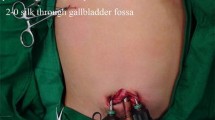Abstract
Background
Conventionally, perforated choledochal cyst (CDC) is a contraindication of laparoscopic treatment. The current study is to evaluate efficacy of single-incision laparoscopic hepaticojejunostomy (SILH) in children with perforated CDCs.
Methods
One hundred and thirty-three children with perforated CDCs who underwent SILHs in our hospital between August 2011 and August 2017 were reviewed.
Results
Fifteen (11.3%) patients were converted to open procedures due to severe adhesions and oozing. The mean age at SILH was 2.09 years (range 2 days–12.37 years). The average operative time was 3.23 h (range 2–5 h). The mean postoperative hospital stay was 6.25 days (range 4–16 days). The mean time to full diet resumption was 2.18 days (range 2–6 days). The mean duration of drainage was 3.71 days (range 3–10 days). The median follow-up period was 24 months. Postoperative liver function tests and serum amylase levels returned to normal within 1 year. Three (2.5%) patients required blood transfusions because of extensive oozing from intramural micro-vessels of CDCs. Two (1.7%) patients encountered duodenal injuries because of severe adhesions. The duodenum was repaired with double-layer 5–0 PDS running sutures. One (0.8%) patient with giant CDC had abdominal fluids because of extensive dissection of intrapancreatic segment of CDC. He recovered after 10 days of drainage. None of patients had bile leak, anastomotic stenosis, cholangitis, intrahepatic reflux, pancreatic leak, pancreatic calculi formation, pancreatitis, Roux-loop obstruction, or adhesive intestinal obstruction.
Conclusions
Single-incision laparoscopic hepaticojejunostomy is safe and effective for selected patients with perforated CDCs in experienced hands.




Similar content being viewed by others
References
Fumino S, Iwai N, Deguchi E, Ono S, Shimadera S, Iwabuchi T, Kinoshita H, Nishimura T (2006) Spontaneous rupture of choledochal cyst with pseudocyst formation-report on 2 cases and literature review. J Pediatr Surg 41(6):e19–e21
Winkler RE, Lancry K, Velcek FT (2001) Choledochal cyst with perforation—an unusual presentation. Case report and review of the literature. S Afr J Surg 39(3):95–96
Ilyas MIM, Tieman J, Alkhoury F (2015) Laparoscopic single stage procedure for perforated choledochal cyst. J Pediatr Surg Case Rep 3(10):436–439
Diao M, Li L, Cheng W (2016) Recurrence of biliary tract obstructions after primary laparoscopic hepaticojejunostomy in children with choledochal cysts. Surg Endosc 30(9):3910–3915
Diao M, Li L, Cheng W (2016) Laparoscopic redo hepaticojejunostomy for children with choledochal cysts. Surg Endosc 30(12):5513–5519
Todani T, Watanabe Y, Toki A, Ogura K, Wang ZQ (1998) Co-existing biliary anomalies and anatomical variants in choledochal cyst. Br J Surg 85(6):760–763
Lal R, Behari A, Hari RH, Sikora SS, Yachha SK, Kapoor VK (2013) Variations in biliary ductal and hepatic vascular anatomy and their relevance to the surgical management of choledochal cysts. Pediatr Surg Int 29(8):777–786
Diao M, Li L, Cheng W (2011) Laparoscopic versus Open Roux-en-Y hepatojejunostomy for children with choledochal cysts: intermediate-term follow-up results. Surg Endosc 25(5):1567–1573
Hay SA (2008) Laparoscopic mucosectomy for large choledochal cyst. J Laparoendosc Adv Surg Tech A 18(5):783–784
Nennstiel S, Weber A, Frick G, Haller B, Meining A, Schmid RM, Neu B (2015) Drainage-related complications in percutaneous transhepatic biliary drainage: an analysis over 10 years. J Clin Gastroenterol 49(9):764–770
Franga DL, Howell CG, Mellinger JD, Hatley RM (2005) Single-stage reconstruction of perforated choledochal cyst: case report and review of the literature. Am Surg 71(5):398–401
Son TN, Thanh Liem N, Manh Hoan V (2014) One-staged or two-staged surgery for perforated choledochal cyst with bile peritonitis in children? a single center experience with 27 cases. Pediatr Surg Int 30(3):287–290
Author information
Authors and Affiliations
Corresponding authors
Ethics declarations
Disclosures
Dr. Mei Diao, Prof. Long Li, and Prof. Wei Cheng declare no conflicts of interest or financial ties to disclose.
Rights and permissions
About this article
Cite this article
Diao, M., Li, L. & Cheng, W. Single-incision laparoscopic hepaticojejunostomy for children with perforated choledochal cysts. Surg Endosc 32, 3402–3409 (2018). https://doi.org/10.1007/s00464-018-6047-x
Received:
Accepted:
Published:
Issue Date:
DOI: https://doi.org/10.1007/s00464-018-6047-x




